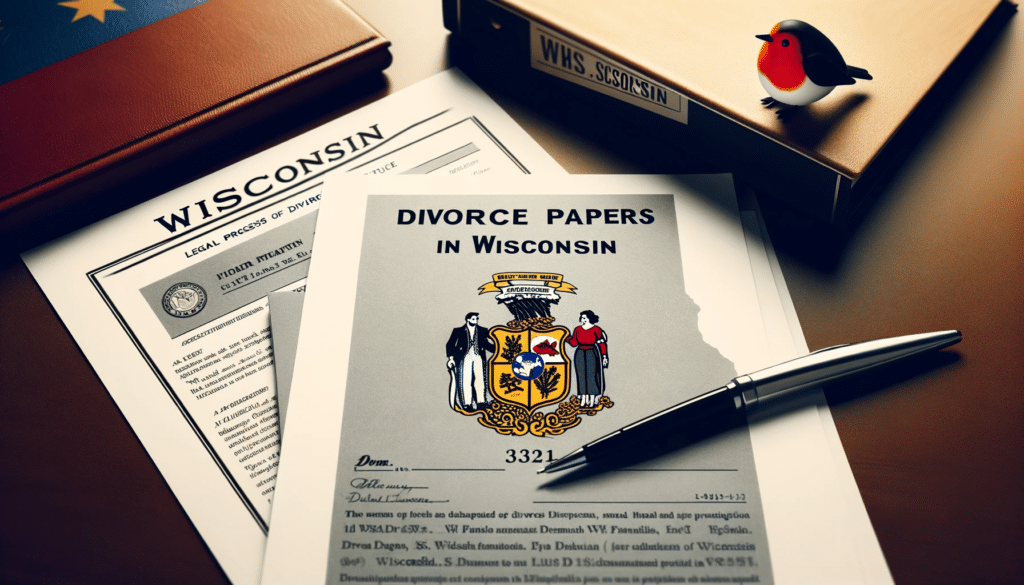Physical Address
304 North Cardinal St.
Dorchester Center, MA 02124
Physical Address
304 North Cardinal St.
Dorchester Center, MA 02124

Setting out to file for divorce in Wisconsin can feel like navigating the intricate waterways of the Great Lakes — a journey that’s both legally complex and emotionally laden. Wisconsin’s unique divorce laws chart a specific course, complete with distinct rules and requirements.
From understanding residency prerequisites to deciphering the complexities of legal paperwork, every step is crucial in this voyage. But, this journey need not be a solitary one. Consider this article your lighthouse, shining a light through the fog of Wisconsin’s divorce laws.

We’re here to break down the legal jargon and empathize with the emotional aspects of this journey. Ready to embark on this path in the Badger State? Keep reading to learn about the key steps for filing for divorce in Wisconsin, and start your journey towards a new beginning with clarity and confidence.
For more on how to file for divorce, check out our article, How to File for Divorce: A Concise Guide for Couples.
In Wisconsin, either you or your spouse must have been a resident of the state for at least six months prior to filing for divorce.
This residency requirement is required to establish jurisdiction in the Wisconsin courts. It is important to note that residency must be maintained throughout the divorce process.
Wisconsin is a no-fault divorce state, which means that the only accepted ground for divorce is that the marriage is deemed “irretrievably broken.”
This means that there is no hope of reconciliation between the spouses, and there is no need to prove fault or wrongdoing on either party’s part.
To initiate the divorce process, a joint petition or affidavit stating that the marriage is irretrievably broken must be filed. Alternatively, the judge must make a finding that the marriage is irretrievably broken based on the evidence presented.
It is often a big help to work with an attorney who can guide you through the legal requirements and help you gather the necessary documentation to support your case.
| Eligibility for Divorce | Grounds for Divorce |
|---|---|
| Either you or your spouse must have been a resident of Wisconsin for at least six months. | The only ground for divorce in Wisconsin is that the marriage is “irretrievably broken.” |

Before filing for divorce in Wisconsin, there certain steps you can take to prepare yourself for the process. To make the process smoother and ensure your best interests are protected, here are some key steps to consider:
By taking these steps to prepare for your divorce, you can be better equipped to navigate the process and protect your rights and interests.
| Document | Purpose |
|---|---|
| Income Tax Returns | Provide evidence of income for both spouses |
| Bank Statements | Show proof of assets and liabilities |
| Mortgage Documents | Provide information on shared property and outstanding debts |
| Retirement Account Statements | Detail retirement savings and investments |
| Insurance Policies | Clarify coverage and beneficiaries |
| Wills and Trusts | Highlight estate planning arrangements |
| Prenuptial or Postnuptial Agreement | Review any existing agreements that may affect the divorce settlement |
Remember, divorce can be emotionally challenging, but with the right preparation and support, you can navigate the process more smoothly and work towards a fair and satisfactory resolution.
Filing for divorce in Wisconsin requires the completion of specific forms that vary depending on your situation. Using the correct forms will help ensure accuracy and avoid delays in the process.
While consulting with a family law attorney is recommended, there are resources available, such as the Do-It-Yourself Divorce method offered by some law offices, for those who choose to file without an attorney.
When preparing the forms, make sure to fill them out accurately and provide all the necessary information. Take your time to understand the instructions and double-check for any errors or omissions.
Provide complete and truthful information to avoid any complications in the future. You can find Wisconsin divorce forms online or at your local county courthouse.
Here are some common divorce forms required in Wisconsin:
| Form Name | Purpose |
|---|---|
| Summons and Petition | Initiates the divorce process and contains information about the parties involved. |
| Confidential Petition Addendum | Provides information about any domestic abuse or child abuse concerns. |
| Financial Disclosure Statement | Details the financial information of both parties, including income, assets, and debts. |
| Child Support Worksheet | Helps calculate child support obligations based on income, expenses, and custody arrangements. |
| Marital Settlement Agreement | Outlines how property, assets, debts, and child-related matters will be divided. |
Once the forms are completed, they should be signed and submitted to the appropriate county’s Circuit Court. Follow the filing instructions provided by the court and pay any required fees. Remember to keep copies of all filed documents for your records.

Divorce cases are handled by the Circuit Court in the county where you or your spouse meet the residency requirements. Each county in Wisconsin has its own Circuit Court, and the divorce petition must be filed with the clerk of courts in that county.
To find the specific Circuit Court where you should file for divorce, you can visit the county’s Circuit Court website or contact the clerk’s office directly. They can provide you with information on the filing procedures, required documents, and any additional requirements specific to your county.
Be sure to file your divorce petition in the correct county to ensure that your case is processed efficiently and according to the law. Filing in the wrong county can lead to delays and complications in your divorce proceedings.
Common divorce forms in Wisconsin include the Petition for Divorce, Financial Disclosure Statement, and Child Support Worksheet.
The Petition for Divorce outlines your reasons for seeking a divorce and the relief you are requesting from the court. The Financial Disclosure Statement requires both parties to provide detailed information about their income, expenses, assets, and debts. The Child Support Worksheet helps determine the appropriate child support payments if children are involved.
Once you have completed the necessary forms, you must serve them to your spouse. Serving divorce papers in Wisconsin requires they be delivered to your spouse within 90 days after filing.
This can be done by hiring a professional process server, using a sheriff’s department officer, or asking an adult who is not involved in the case to serve the papers. It is crucial to keep proof of service, as it will need to be submitted to the court.
| Form Name | Purpose |
|---|---|
| Petition for Divorce | Initiates the divorce process and states the relief sought |
| Financial Disclosure Statement | Provides detailed information about income, expenses, assets, and debts |
| Child Support Worksheet | Determines appropriate child support payments if children are involved |
| Summons | Notifies the other party of the divorce filing and court appearance |
| Stipulation for Temporary Order | Addresses temporary issues such as custody and support during the divorce process |
| Findings of Fact, Conclusions of Law, and Judgment | Finalizes the divorce and includes the court’s ruling on the issues |

If you have been served with a divorce petition in Wisconsin, you have the opportunity to file a response.
Your response should address each issue raised in the petition, such as child custody, child support, and property division. It is highly recommended to consult with an attorney to ensure that your response is properly prepared and accurately reflects your position on these matters. A qualified attorney can guide you through the legal process and help protect your rights and interests.
When preparing your response, provide clear and concise answers to each issue raised in the divorce petition. Be sure to include any relevant counterclaims or requests for modifications to the petitioner’s proposed arrangements.
Your response should also outline your preferred arrangements for child custody, visitation schedules, financial support, and the division of marital assets and debts.
Submit your response within the required time frame, typically within 20 or 30 days of being served with the divorce petition.
Failure to file a response within this time frame could result in the court proceeding with a default judgment, which may not be favorable to your interests. By promptly responding and seeking legal guidance, you can actively participate in the divorce process and work towards achieving a fair and satisfactory outcome.
When going through a divorce in Wisconsin, both parties are required to provide financial disclosures. These disclosures are essential in ensuring transparency and fairness in the division of assets, liabilities, and determination of child support.
Financial disclosures must be completed accurately and honestly, as any deliberate attempt to hide assets or withhold information can have serious consequences.
Financial disclosure statements typically include details about income, expenses, assets, and debts. You will need to provide information about your employment, sources of income, bank accounts, investments, real estate, vehicles, and any other valuable property you own.
Be thorough in listing all your assets and debts, as well as any ongoing financial obligations, such as spousal support or child support from a previous marriage.
The purpose of these disclosures is to ensure that both parties have a complete picture of the financial situation and can make informed decisions during the divorce process. It also helps the court in making fair and equitable rulings when it comes to property division and financial support arrangements.
| Category | Your Information | Spouse’s Information |
|---|---|---|
| Income | $5,000 per month | $4,500 per month |
| Savings Accounts | $10,000 | $15,000 |
| Investments | $50,000 | $30,000 |
| Real Estate | Primary residence ($300,000) Rental property ($200,000) |
None |
| Debts | Credit card ($5,000) Car loan ($15,000) |
Student loan ($20,000) |
It is recommended to consult with a family law attorney to ensure that you are fulfilling your financial disclosure obligations properly. An attorney can guide you through the process, provide advice on what information is necessary to include and help you understand the potential impact of the disclosures on your case.
Filing for divorce in Wisconsin may seem daunting, but with the right knowledge and guidance, you can successfully navigate the process.
By following the steps above, seeking legal advice, and considering the best interests of any children involved, you can bring the divorce process in Wisconsin to a close and move forward with your life.
To see how this process of filing for divorce in Wisconsin compares to that in other states, check out our articles about how to file for divorce in Illinois and filing for divorce in Minnesota.